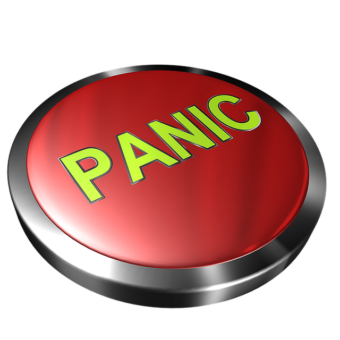Manifestations/Demonstrations
In continuing to address the matter of finding a new church after an experience in an unhealthy one, let’s consider the issue of manifestations, or demonstrations. This will mainly pertain to those from Pentecostal type backgrounds and I realize that some may not appreciate what I have to share, but try to hear me out.
In many Pentecostal type churches, there can be an overemphasis on emotions, excitement, lively music and having what can be termed as manifestations or demonstrations. This is often seen as people crying, shouting, praying loud, jumping, dancing, running, raising/waving/shaking their hands, speaking in tongues, etc. In some circles, anything outside of this may be considered as dead, dull and boring. I briefly touched on this in Part One. If such are not seen, the person may believe that the Holy Spirit was not present or people were not yielding, or allowed to yield to Him, or that they did not hear from God. I remember learning that one woman felt they did not hear from God unless there were tongues and interpretations in a service.
It can be a huge step out of one’s comfort zone to attempt to visit a church outside of their former group. They may have been told all their life that other churches are dead. They may have heard that they quench the Holy Spirit in services. They may have even heard that people in other churches do not even know God. It can take a great deal of courage and determination to visit one of these other churches when your background is Pentecostal.
When believers gather together, Paul taught in 1 Corinthians that it should be with the purpose of everyone being strengthened, encouraged, edified and helped. The church at Corinth appears to have been trying to major in manifestations. Yet in doing so, they were neglecting to see to it that all were edified. It also appears that they were not operating in love. Manifestations and lively services are not necessarily synonymous with people being changed and helped.
Chapter 13 has to do with being part of the body of Christ and in the use of spiritual gifts. Paul shared that people could do all manner of things outwardly, but if what they did was not done through love, they were nothing more than noise makers. Some people ‘demonstrate’ to be seen as more spiritual, and to be recognized and praised of men. One is never acting out of love in such cases.
Jesus and the early church taught believers to not seek after signs. In this, they were not teaching that one should reject or avoid them, but rather that the focus not be placed upon them. Even when the disciples were sent ahead of Jesus into some towns, and had been given the power and authority to do miracles and cast out devils, Jesus told them not to rejoice in those things but to rejoice because their names were written in heaven.
What I am sharing should not be taken as being against spiritual gifts or lively worship. The point is that we who are from a Pentecostal type background can unnecessarily limit our choices of churches by eliminating all non ‘Spirit-filled’ ones from a list of possibilities. The Holy Spirit is just as able to move and touch people in a ‘dead’ church as He is in a ‘lively’ one. Whether a song is a hymn or a vibrant one, does not limit God. Whether a singer sings to live music or a soundtrack, has no bearing on what God can accomplish.
Many of us forgot that Jesus said where two or three believers are gathered together in His name, He would be in their midst. He didn’t limit the location. He didn’t say only if there was lively music, nor did He say only if it was in a tongue-talking church. If you are gathering with other believers in a so-called ‘dead’ church, and claim God is not there, then you are not believing what Jesus said. You are actually the one that missed Him in the gathering and not the others present.
It can be difficult for some to believe that God can move and touch people in a quieter service. But where did this thought come from? When Jesus walked the earth, were those he healed or helped running around, jumping or shouting at the time he met their need? When the lame man was at the gate, did Peter tell him that if he only worshiped more or prayed louder, he would be healed? When the woman with the issue of blood approached Jesus, was she told that if she had only danced around she would have been healed? When Elijah challenged the prophets of Baal in offering a sacrifice, weren’t they thinking they’d be heard due to their loud worship and their physical demonstrations? Did Elijah believe God would only accept his sacrifice if he, too, was demonstrative and loud?
Because you may not see the reactions you expect or are accustomed to, does not mean God’s presence is not there. Perhaps you have expected a certain type of atmosphere for so long that you cannot perceive God moving in silence, quietness or less vibrant worship. But just because you may not see it does not mean it is not happening. It might surprise you if you took time to talk to others and discovered how God met needs, all while you felt He was nowhere to be found.
Yes, it can be difficult for those used to a certain way to then attend a different type of church. But if you can push past your preconceived ideas and realize how God is not limited by the manner of worship or preaching, you might find yourself strengthened, edified and encouraged. That ‘dead’ church might be just the place for you to rest awhile and heal some.
Leaving An Unhealthy Church #1: You and Those Who Remain
Leaving An Unhealthy Church #2: Anything You Say Can, And Will, Be Used Against You
Leaving An Unhealthy Church #3: Why It May Be Important To Resign Your Membership
Leaving An Unhealthy Church #4: Remaining in the Same Organization
Leaving An Unhealthy Church #5: Don’t Listen To The Gossip
Leaving an Unhealthy Church #6: How You Are Treated
Leaving an Unhealthy Church #7: It Happens To Ministers, Too
Leaving an Unhealthy Church #8: The Way Of The Transgressor Is Hard!
Leaving an Unhealthy Church #9: Some Must Return To Remember Why They Left
Leaving An Unhealthy Church #10: Sorting Through The Teachings
Leaving an Unhealthy Church #11: Confusion & Not Knowing Who or What to Believe
Leaving An Unhealthy Church #12: Can I Go To A Church Where I Don’t Agree With Everything?
Leaving An Unhealthy Church #13: A Warped View of God
Leaving An Unhealthy Church #14: Looking For A New Church Part 1
Leaving An Unhealthy Church #15: Looking For A New Church Part 2 (Leaving Your Comfort Zone)
Leaving An Unhealthy Church #16: Looking For A New Church Part 3 (Triggers)
Leaving An Unhealthy Church #17: Looking For A New Church Part 4 (Manifestations/Demonstrations)
Leaving An Unhealthy Church #18: Looking For A New Church Part 5 (Church Attendance: A Matter of Life or Death?)
********
Shop at our Amazon store! As an Amazon Influencer, this website earns from qualifying purchases.



 Another area of difficulty can be your concentration. You may find your mind wandering off in a service and also when you try to read. This is also very normal. Should you find yourself not listening to what is being taught or unable to focus on reading something from the Bible (as well as other books), understand that this happens. At the same time, when it comes to the service, check yourself to see if it is an overall difficulty with concentrating or if the minister isn’t providing anything edifying and that is what is causing your inattention.
Another area of difficulty can be your concentration. You may find your mind wandering off in a service and also when you try to read. This is also very normal. Should you find yourself not listening to what is being taught or unable to focus on reading something from the Bible (as well as other books), understand that this happens. At the same time, when it comes to the service, check yourself to see if it is an overall difficulty with concentrating or if the minister isn’t providing anything edifying and that is what is causing your inattention.
 When one is used to seeing people dressed differently, it can be a shock to see otherwise. It can be so distracting that they cannot concentrate on the message or worship. They may find themselves judging people, especially those on the platform. They may catch themselves thinking, “How could the pastor dress casually? And the worship leader has on pants. Look at the women in the choir with all that make-up and jewelry!”
When one is used to seeing people dressed differently, it can be a shock to see otherwise. It can be so distracting that they cannot concentrate on the message or worship. They may find themselves judging people, especially those on the platform. They may catch themselves thinking, “How could the pastor dress casually? And the worship leader has on pants. Look at the women in the choir with all that make-up and jewelry!”

 Some need space after leaving and they desire to stay away from any church so that they can understand what happened to them and unravel some of the teachings. One’s foundation may have crumbled and everything may feel shaky. Yet others are so shell-shocked from their abusive church that they cannot fathom attempting to visit a new one, but given some time and space will do so in the future. Some will want nothing to do with churches ever again. Others go the route of a home church. A person needs to feel out what is right for them at this time. Their preference may later change and guess what- that is perfectly fine. During their healing time, people may need something different for awhile. Those who have exited unhealthy churches don’t need to be pressured or berated because they do not immediately start attending another church.
Some need space after leaving and they desire to stay away from any church so that they can understand what happened to them and unravel some of the teachings. One’s foundation may have crumbled and everything may feel shaky. Yet others are so shell-shocked from their abusive church that they cannot fathom attempting to visit a new one, but given some time and space will do so in the future. Some will want nothing to do with churches ever again. Others go the route of a home church. A person needs to feel out what is right for them at this time. Their preference may later change and guess what- that is perfectly fine. During their healing time, people may need something different for awhile. Those who have exited unhealthy churches don’t need to be pressured or berated because they do not immediately start attending another church. Some pastors teach that every other church in the area, including others with similar beliefs, are trash cans and to be avoided at all costs. Think about this… The unhealthy pastor wants to keep you coming to that church. You give money that lines his pockets. You probably labor there in some way, too, and don’t get paid. By claiming that there is nowhere else to go in the area, it keeps people confined to that church, or should they be brave enough to leave, they won’t go elsewhere because they still believe the fear laced lies.
Some pastors teach that every other church in the area, including others with similar beliefs, are trash cans and to be avoided at all costs. Think about this… The unhealthy pastor wants to keep you coming to that church. You give money that lines his pockets. You probably labor there in some way, too, and don’t get paid. By claiming that there is nowhere else to go in the area, it keeps people confined to that church, or should they be brave enough to leave, they won’t go elsewhere because they still believe the fear laced lies.
